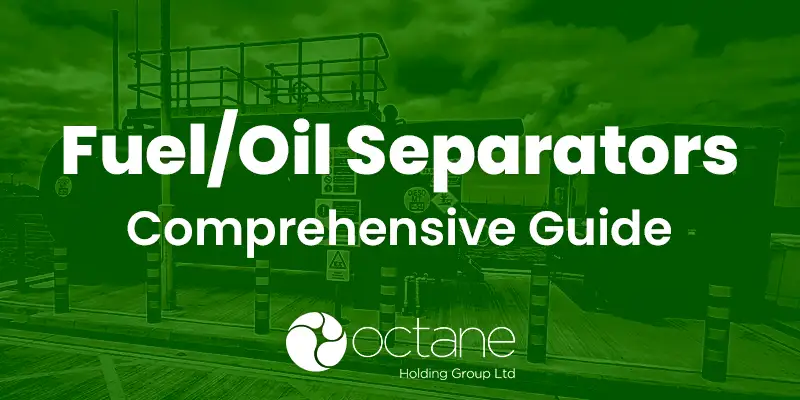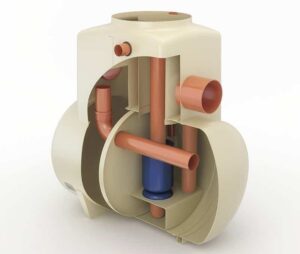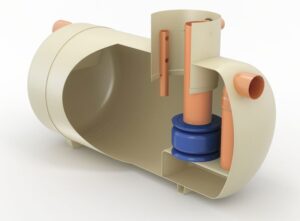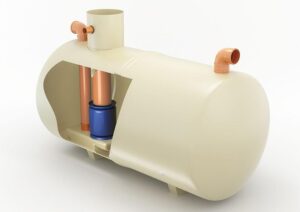Latest News
Keep up to date with latest news and insights from Octane Holdings

Fuel/Oil Separators [Interceptor Tanks] Guide
Fuel/oil separators play a significant role in managing contaminated run-off and spills. If you don’t have the right type of separator or it’s poorly maintained, serious problems can occur.
The worst outcome is to see fuel or oil contaminate local waterways. The environment suffers of course, but so does your bottom line – the Environment Agency has a track record of issuing significant fines to businesses for failing to stop spills.
I’ve put together this guide about fuel/oil separators so you can make the right choice for your business and help to avoid costly mistakes.
I’ll start by explaining a bit about what fuel/oil separators do, how they work and the different types you can get. Then move on to how to keep your separators/interceptors maintained and also what can happen if you don’t.
What are fuel/oil separators?
First of all, you might know separators as interceptors, which is their old name, so I am talking about the same infrastructure. Generally speaking, most separators in use today are single pots with coalescent filters and are used to collect and filter out fuel and oil found in surface water run-off from carparks, fuel station forecourts, vehicle muster points and so on.
Older infrastructure may use a slightly different kind of separator with a 3-chambered tank that filters contaminants into different chambers.
Whichever filtering system is in use the end goal is the same: the contaminants are contained in the separator and the water is released into drains, soakaways or sewers minimising any possible pollution.
Do I need a fuel/oil separator?
If your site has hard surfaces that will have oil or fuel contaminating the water run-off, it’s likely you’ll need to install a separator. There are different types for different scenarios, which I’ll explain below. Some examples of sites requiring a separator:
- Vehicle muster points and maintenance areas
- Roads
- Industrial workshops
- Refuelling facilities (including commercial and industrial forecourts)
- Small car parks that discharge run-off into a sensitive environment such as a designated nature reserve or waterway
- Car parks that have 50 or more spaces, or are larger than 800m2
Types of fuel/oil separators
There are three different types of separators. They all work in a similar fashion but are designed to cope with different volumes and contaminant requirements.
Bypass Separator
Bypass separators are designed for sites that have low rainfall and low risk of contaminant spills, like short term car parking, for example. Bypass separators work well for locations that experience water flows generated by rainfall, up to 6.5mm/hour.

These will cover around 99% of all rainfall events, but will allow heavier rainfalls to circumvent the separator (while processing as much as capacity will allow).
Bypass separator sizing guide
If you need help with sizing take a look at our bypass separator sizing guide for assistance.
Full Retention Separators
Full retention separators are built to handle much higher flows, up to 65mm/hr. Full retention separators are better suited to locations that experience very heavy rainfall, and/or a risk of high-volume spills.

Vehicle maintenance sites and heavy vehicle parking are locations which typically have this type of separator installed.
Full retention separator sizing guide
If you need help with sizing take a look at our full retention separator sizing guide for assistance.
Forecourt Separator
And lastly, forecourt separators, as the name suggests are best suited for refuelling sites and forecourts. They are designed to retain an entire fuel spill, up to the predicted maximum capacity of an on-site spill (usually the volume of a compartment of a fuel delivery tanker, or 7600 litres).

Octane can supply and install all the fuel/oil separators listed above. Get in touch with us today to find out more.
Regulations around fuel/oil separators
Fuel/oil separator installation and maintenance was regulated in England by the Environment Agency’s PPG3 document until December 2015 when it was withdrawn. This does however still function as good practice guidance in Northern Ireland, Wales and Scotland.
New guidance issued by the government is pollution prevention for business. Additionally, the European standard EN858-2 is currently applicable in the UK as of the date this guide was written.
Fuel/oil Separator maintenance requirements
The regulations above require inspections and separator maintenance to be conducted every 6 months. It’s absolutely necessary to service your separators and ensure they are cleared of accumulated build up regularly.
There are a number of tasks to be undertaken during separator or interceptor cleaning. The servicing should be conducted by an experienced team that has the appropriate training and safety qualifications.
Here’s a list of tasks you can expect a maintenance contractor to undertake during separator cleaning and servicing:
- Inspect the integrity of the separator and all mechanical parts,
- Inspect all filters and replace or repair as required,
- Assess the amount of collected contaminants (oil and fuel) and silt,
- Service any electrical systems including volume alarms and any interceptor management systems,
- Inspect the coalescing device if installed, and replace if required,
- Conduct safe silt/contaminant removal in accordance with waste transit and disposal regulations,
- Install new separators to meet site and regulatory requirements,
- Inspect supporting infrastructure such as gullies, manholes and pipework,
- Maintain industry standard documentation,
- Maintain logs of inspections, maintenance, incidents, services and contaminant removal.
Fines issued
The consequences of failing to maintain your fuel/oil separators can be severe. They are a key line of defence against spills that can be dangerous and potentially lethal for the Environment, so it’s in your company’s interest to have them in excellent condition.
“If you pollute, you could get an unlimited fine, go to prison for up to 5 years, or both. You may also have to pay for the whole cost of the clean-up. There could be further costs such as paying compensation to third parties, higher insurance premiums or loss of contracts.”
The Environment Agency has taken legal action against companies that caused environmental damage due to poorly maintained separators. I’ve collected a few recent examples to give you an idea.
In 2010, VK Transport failed to empty their interceptor, which caused an overflow into a surface-level sewerage system. That system flowed directly into the River Thames. It resulted in fuel contaminating the river which caused significant environmental damage (not to mention the costs of the clean-up operation). They were fined £4,000 plus court costs.
Also in 2010, Thames Water was fined over £12,000 for two offences relating to poorly maintained separators. The pumps on the first separator had faulty sensors, which caused 4500 litres of diesel to spill into a waterway. The second interceptor’s drain became blocked with silt which caused another spill (of raw sewerage in this case).
In 2014, company Eco Oil was fined £30,000 for allowing a spill to occur in 2012. The separator was overwhelmed by heavy rain, which caused the collected contaminants to overflow into a drain which let out into the River Orwell.
Additionally, the volume sensors had been decommissioned because they hadn’t been working properly. The fuel spread 4 miles downriver, contaminating sensitive environmental areas, and killed wildlife.
Conclusion
Hope this guide has been useful. The issues and subsequent fines highlighted above, could easily have been avoided if proper maintenance had been conducted. It’s a good reminder to inspect your separators regularly, and have them serviced or emptied as required in addition to your biannual inspections. By doing so you will not only protect your finances but also the environment.
How can Octane help?
Octane are a Klargester accredited installer and can install and maintain your fuel/oil separator, adhering to both UK and EU regulation standards.
Our service personnel are highly experienced and have SPA Safety Passports alongside specialist skillsets like first aid and safety awareness training. If you’d like to find out more contact us now on 0113 2012 460.

